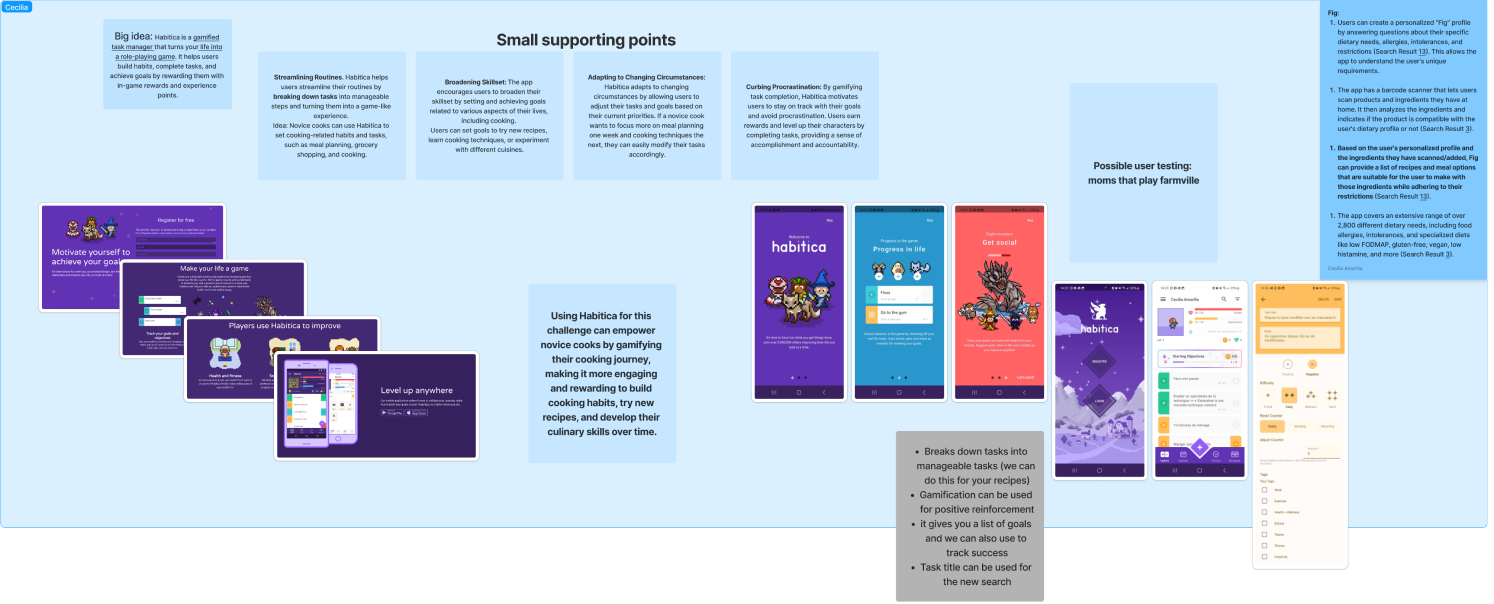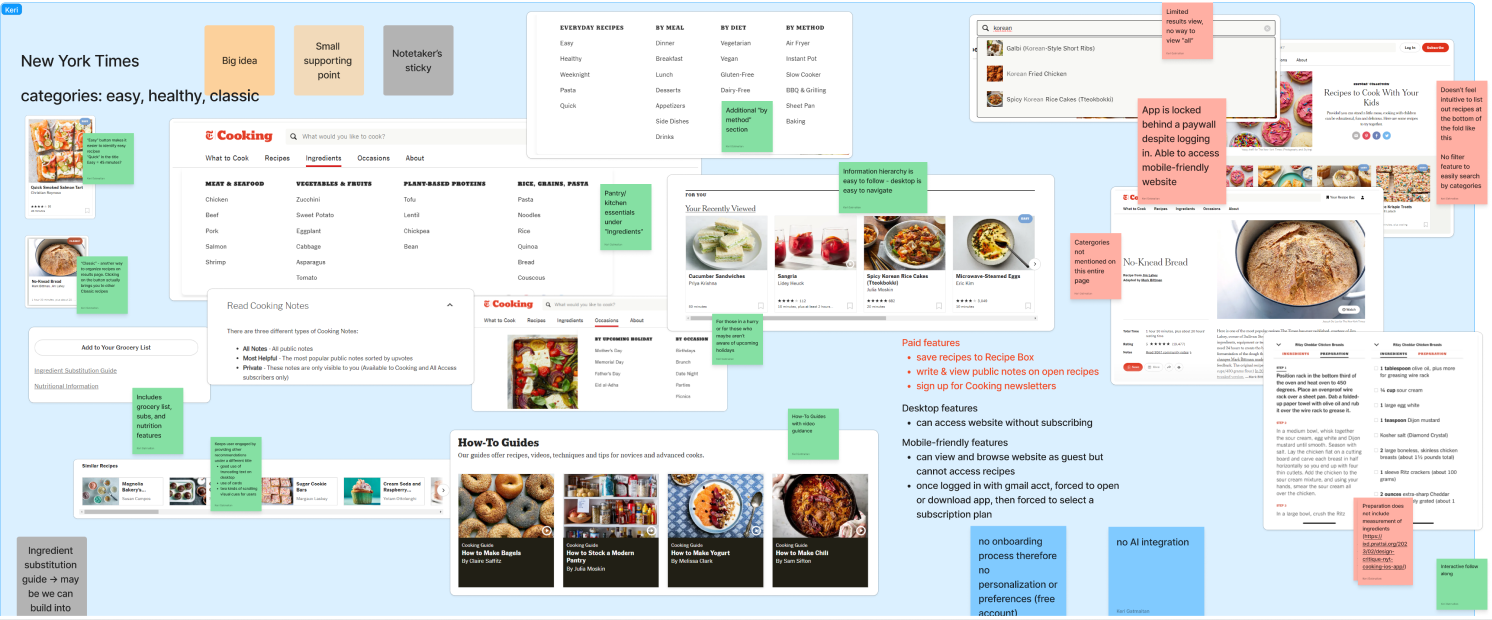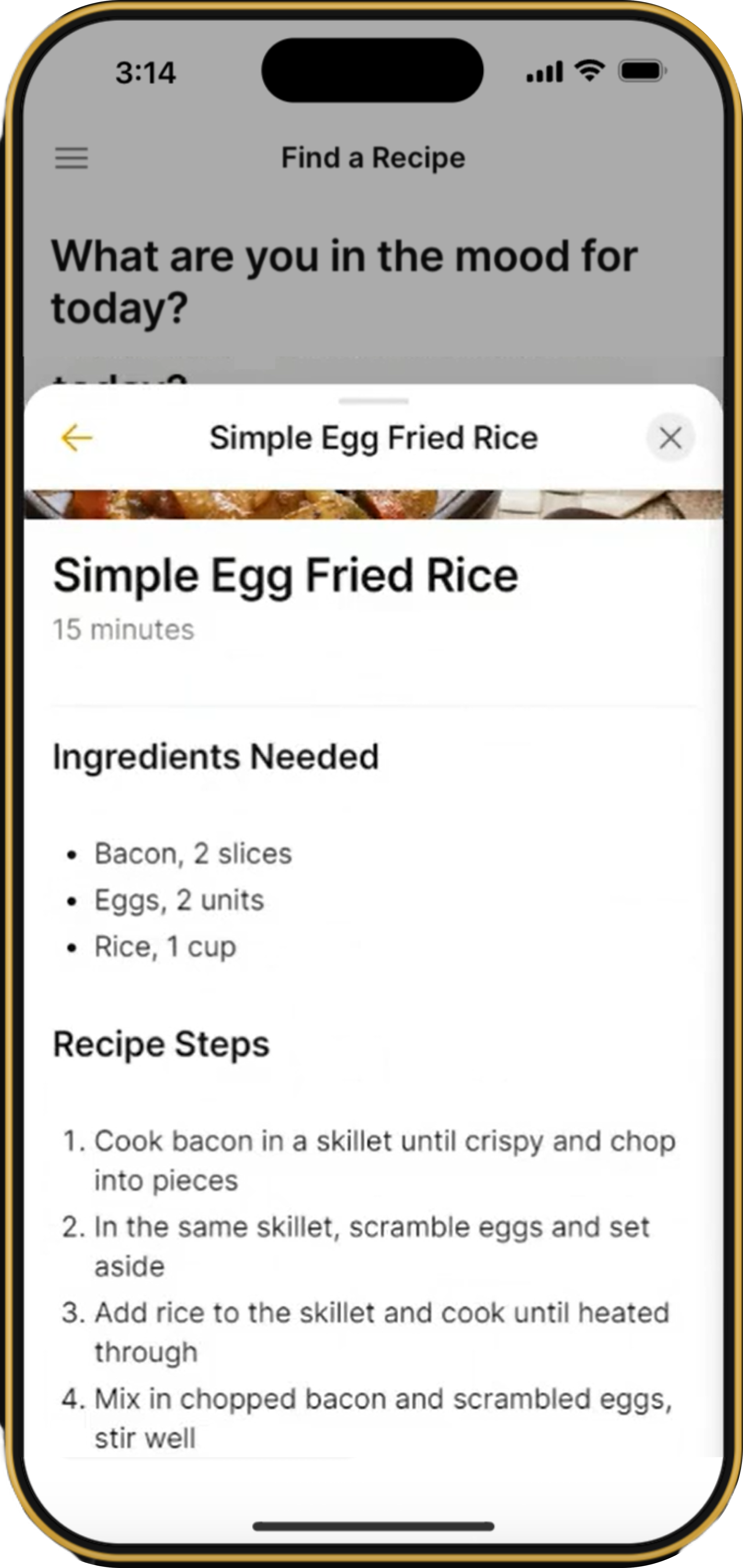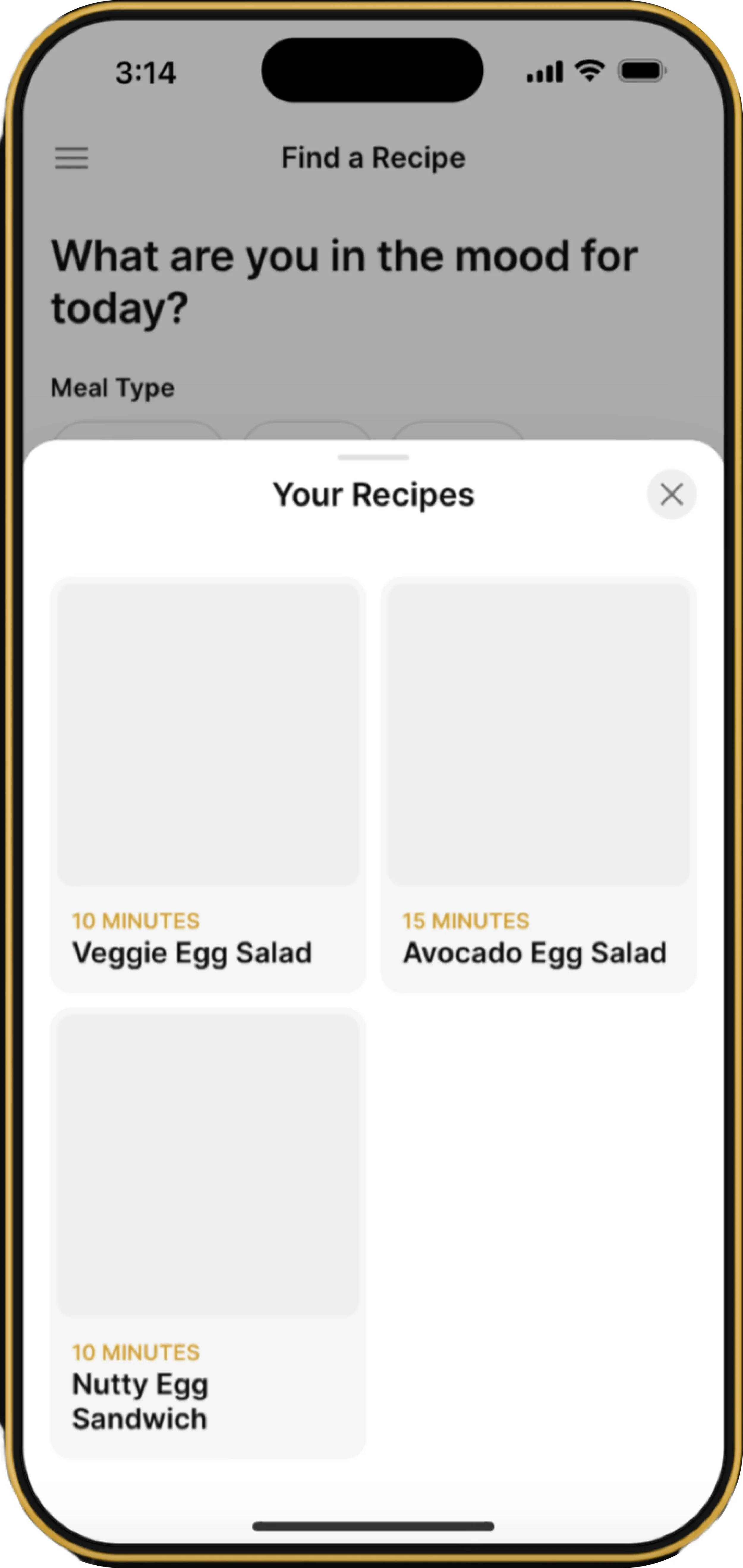Have you ever struggled to find recipes that fit your preferences, restrictions, and ingredients? You're not alone—many face decision fatigue, wasted time, and lost confidence in the kitchen.
Our app helps people like you with personalized, easy-to-follow recipes and efficient ingredient planning, making cooking stress-free and enjoyable.
ROLE
UXR
Provided UX/UI support
TIMELINE
30 Days
TOOLS
Glide, Make, FigJam / Figma, Google Suite, ChatGPT, Open AI
Project Overview:
This project involved creating a Minimum Viable Product (MVP) to solve the problem of novice cooks struggling to find personalized recipes.
Problem
Novice cooks have a hard time finding recipes personalized to their preferences, restrictions, and ingredients on hand, leading to decision fatigue, wasted time, and low confidence in the kitchen. This prevents them from cooking again, creating a negative cycle that hinders their ability to develop cooking skills and enjoy home-cooked meals.
Solution
An AI-powered recipe generator app that personalizes recipes based on users' preferences, dietary restrictions, and available ingredients, thereby reducing decision fatigue, saving time, and increasing confidence in the kitchen. This encourages novice cooks to cook more frequently, fostering skill development and enjoyment of home-cooked meals.
Research
-
Market Size and Growth
Current Size:
The global recipe apps market was valued at approximately USD 0.7 billion in 2023.
Future Growth:
It is expected to reach USD 2.6 billion by 2033, with a CAGR of 14.3% during the forecast period from 2024 to 2033. These figures differ from your summary, which cited lower values and growth rates.
Drivers and Limitations
Drivers:
Increasing health consciousness and demand for personalized cooking solutions.
Technological advancements, particularly in AI and machine learning, enhancing user experience and personalization.
The integration of smart kitchen devices, expanding the market's potential.
Home Cooking Boom: Post-pandemic increase in home cooking drives need for AI-driven recipes.
Time-Saving Convenience: AI recipes offer quick, personalized meal ideas for busy lives.
Tailored Recommendations: Advanced AI provides recipes matching personal tastes and dietary restrictions.
Smart Home Integration: Connections to smart devices and voice assistants make cooking hands-free.
Monetization Potential: Opportunities for revenue through premium features, subscriptions, and partnerships.
Limitations:
High competition from established players in the market.
Privacy concerns regarding the data collected by these applications. While the search results don't explicitly mention limitations, these points are reasonable considerations for this market.
Competitive Landscape:
Key players include Yummly, Epicurious, BigOven, Mealime, Paprika, BuzzFeed Inc., Samsung Food, SideChef Inc., Allrecipes, NYT Cooking, Kitchen Stories, BBC Good Food, Tasty, Oh She Glows, Food Network in the Kitchen, Allrecipes Dinner Spinner, Cookpad, and Weber Grills.
Success depends on standout features and smart monetization.
Opportunities and Threats
Opportunities:
Rising demand for convenient cooking solutions.
Growing interest in personalized recipe recommendations.
Expansion into new markets with increasing smartphone use.
Threats:
High competition from established players.
Potential privacy issues regarding user data.
Total Addressable Market (TAM):
Projected Range: USD 2.6 billion by 2033.
CAGR: 14.3%, driven by evolving consumer preferences and tech advancements.
-
Target Demographics
Busy professionals.
Health-conscious consumers.
Parents.
Novice cooks.
Fitness enthusiasts.
Elderly individuals.
Personas
Susan: A 32-year-old professional struggling to find time for meal planning.
Charles: A 45-year-old health-conscious individual looking for nutritious meal plans.
Michael: A 28-year-old novice cook seeking simple and easy-to-follow recipes.
-
Competitive Landscape
Key players in the AI recipe app market include Yummly, Epicurious, BigOven, Mealime, Paprika, BuzzFeed Inc., Samsung Food, SideChef Inc., Allrecipes, NYT Cooking, and Kitchen Stories. These competitors serve different market segments, ranging from casual home cooks to professional chefs.
Market Segmentation:
Yummly and Mealime primarily target health-conscious individuals with meal planning and nutritional tracking features.
Cookpad focuses on a community-driven approach, encouraging users to share their own recipes and cooking experiences.
Technological Advancements:
The integration of AI and machine learning for personalized recommendations is a significant trend, with competitors like Yummly and BigOven leveraging these technologies to enhance user experience through personalized recommendations and smart grocery lists.
User Experience and Interface:
Paprika and BigOven excel in providing robust organizational features, such as recipe management, meal planning, and grocery list integration, enhancing user engagement with a seamless user interface and intuitive navigation.
Content Quality and Variety:
High-quality, diverse recipe databases are crucial for success. Competitors like Epicurious offer curated content from professional chefs, while Cookpad and BigOven provide extensive user-generated content, adding variety but sometimes compromising on quality control.
Monetization Strategies:
The freemium model is prevalent, with 70% of apps offering basic features for free and premium features at a cost. Yummly and Mealime offer premium features such as personalized meal plans and advanced nutritional insights as part of their subscription packages.
Community and Social Features:
Cookpad and BigOven have strong community features, allowing users to interact, share recipes, and provide feedback, fostering a sense of community. Competitors are increasingly incorporating social sharing features to enhance engagement and attract new users through word-of-mouth.
Global Reach and Localization:
Some competitors have a strong global presence, offering localized content and language support to cater to diverse markets. While specific mentions of localization efforts by Yummly and Epicurious were not found, there is a growing emphasis on diverse cuisines and dietary requirements.
Market Size and Growth Projections:
The global recipe app market is expected to reach USD 2.6 billion by 2033, growing at a CAGR of 14.1% or 14.3% (slight discrepancy between sources) from 2024 to 2033.
To succeed in this competitive landscape, AI recipe apps need to offer unique, personalized, and tech-forward solutions that stand out from the established players.
-
Trends
Increasing popularity of personalized meal planning and recipe suggestions.
Growing use of AI and machine learning to enhance user experience.
Integration with smart kitchen appliances.
Opportunities
Expanding into niche markets such as vegan or gluten-free meal planning.
Collaboration with grocery stores for integrated shopping lists.
Developing unique features like diet tracking and nutritional analysis.
Rising Demand for convenient cooking solutions and personalized recommendations.
Expansion into new markets with increasing smartphone use.
Threats
High competition from established players.
Potential privacy issues regarding user data.
-
-
Survey Methodology
Given the urgency of our timeline, we opted to forego the use of a paid interview recruitment platform and instead relied on screener questions to effectively filter participants. To maximize reach, we extensively shared the survey link across various platforms, including LinkedIn, Facebook, other social media channels, and even through personal contacts.
-
Survey Results
Demographics:
Age Distribution: The majority of respondents fall within the 25-34 age range.
Interest in Further Interviews: Some participants provided their email addresses, expressing interest in participating in follow-up interviews.
Cooking Frequency
Daily: A notable proportion of respondents cook daily.
3-5 Times a Week: This is the second most frequent cooking pattern.
Rarely or 1-2 Times a Week: A smaller group of respondents falls into these categories.
Use of Online Recipes
High Utilization: Most respondents rely on online recipes for their cooking needs.
Desire to Cook More:
Diverse Preferences: Respondents are evenly split between those who wish to cook more and those who do not.
Cooking Confidence:
Moderate to High: The majority of respondents rate their cooking confidence between 3 and 5 on a scale of 5.
Time Spent Planning Meals:
Varied Duration: Respondents generally spend between 10-15 minutes and 30 minutes planning their meals.
Challenges Faced:
Recipe Adjustment: Many respondents find it challenging to modify recipes based on available ingredients or dietary needs.
Recipe Variety: 40% of respondents feel they lack variety in the recipes they can access.
Decision Overwhelm: 33.3% of respondents often feel overwhelmed by the number of decisions involved in meal planning.
Organization Issues: 33.3% of respondents struggle with organizing their cooking process.
Use of Meal Planning Apps:
Limited Adoption: Only 4 out of 12 respondents use meal planning or prep apps and report moderate satisfaction with these tools.
Interest in Meal Suggestion Apps: Many respondents expressed interest in an app that suggests meals based on their preferences and available ingredients.
Specific Observations:
Younger Respondents (12-17 years old): Cook less frequently and exhibit lower confidence in their cooking skills.
Young Adults (18-24 years old): Those who cook daily demonstrate higher confidence and are less likely to feel overwhelmed or face planning challenges.
Adults (25-34 years old): Show a higher frequency of daily cooking, moderate to high confidence, and varied satisfaction with meal planning apps.
Adults (35-44 years old): Frequently cook 3-5 times a week and show a keen interest in meal suggestion apps.
Opportunities for Improvement:
App Development: There is a notable opportunity to develop an app that suggests meals based on available ingredients and user preferences, potentially reducing decision fatigue and increasing recipe variety.
Recipe Adjustment Support: Creating tools or features that facilitate easy recipe adjustments could address common issues related to dietary restrictions and ingredient availability.
Enhanced Meal Planning Tools: Given the mixed satisfaction with current apps, there is potential for developing more user-friendly and comprehensive meal planning solutions.
Ideation and Concept Development
The team engaged in a series of structured brainstorming sessions to generate and refine ideas:
Crazy 8s: Team members quickly sketched out eight different ideas in eight minutes to spark creativity and explore a broad range of solutions. Inspired by Sprint, we then worked on a Solution Sketch each.
⬇︎
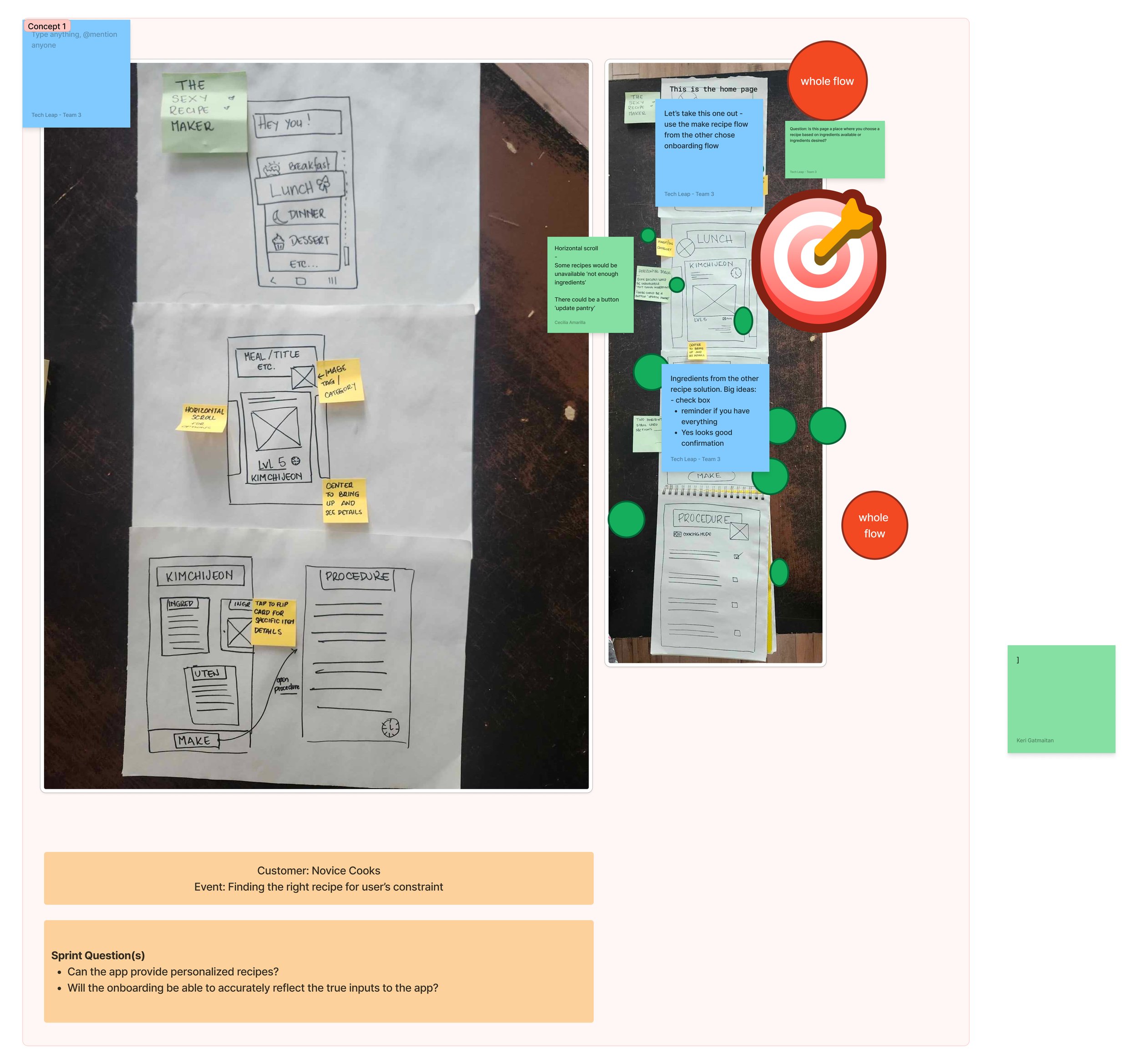

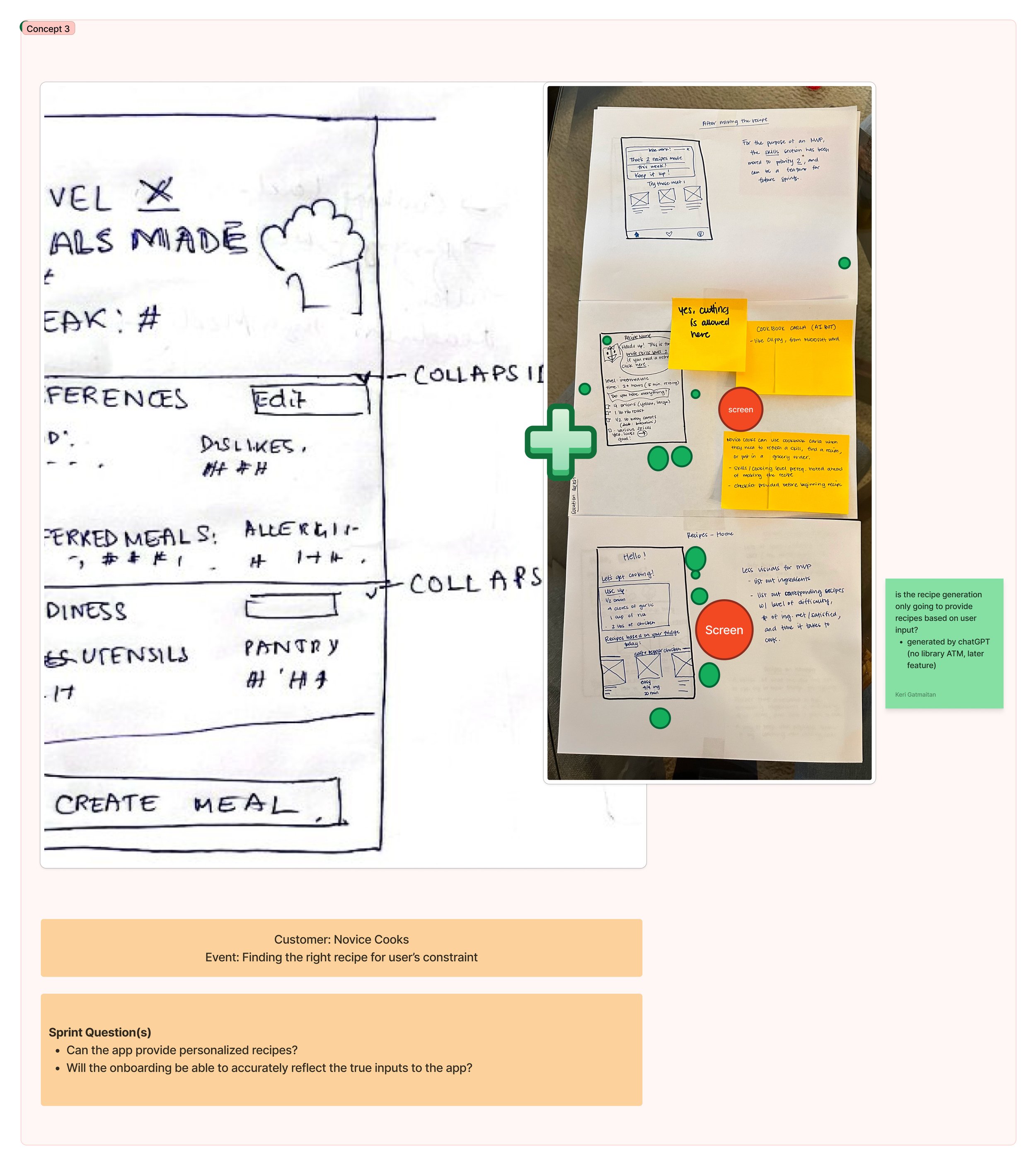
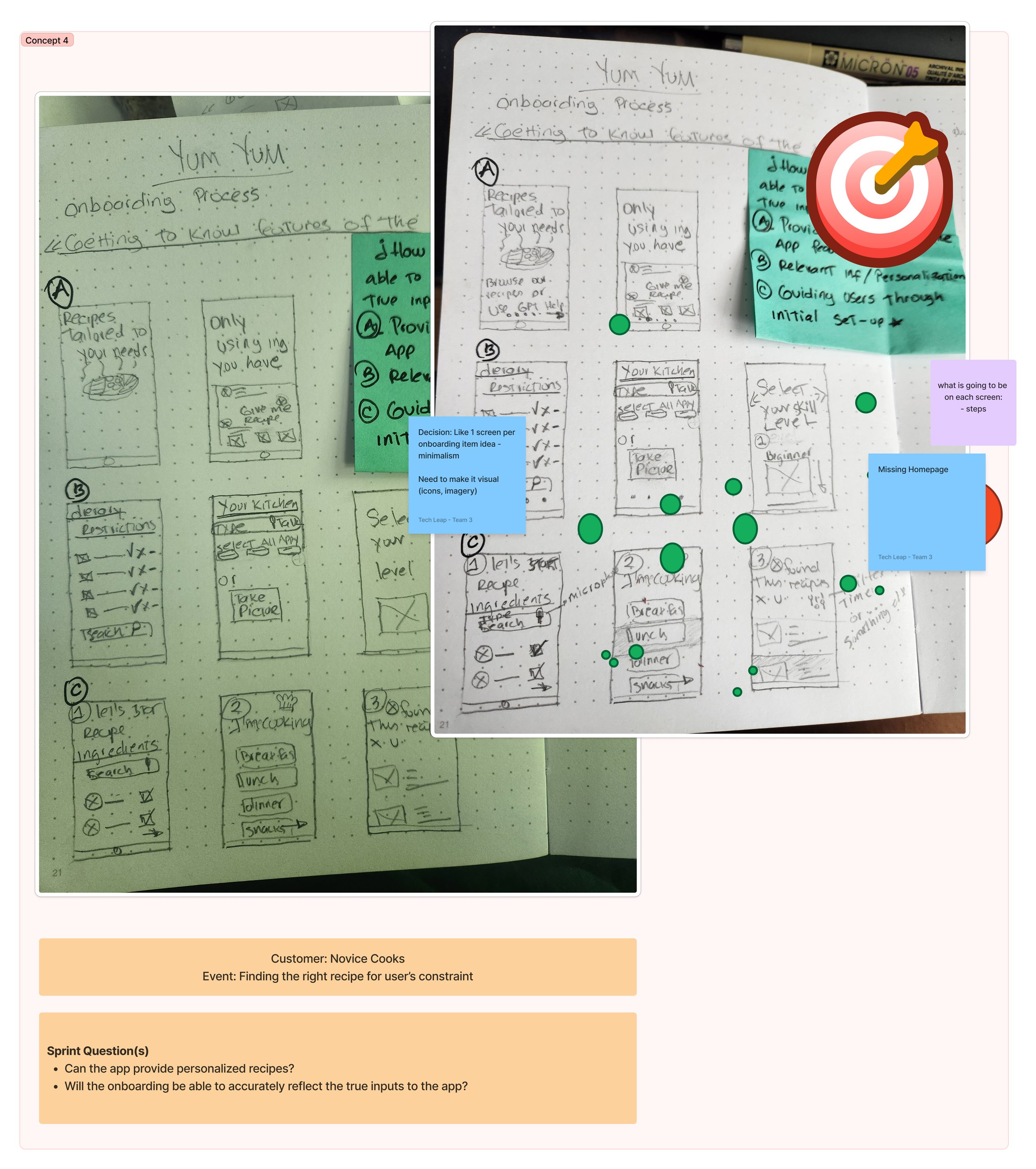
Art Museum: We displayed all the sketches in a gallery-style setup, allowing team members to review and provide feedback on each idea.
Heat Map: We used heat mapping to identify and prioritize the most promising ideas based on team votes and interest.
Straw Poll: A quick poll was conducted to gauge initial preferences and select ideas for further development.
Speed Critique: Ideas were rapidly reviewed and critiqued to highlight strengths, weaknesses, and areas for improvement.
Super Vote: Finally, the PM led a 10-minute Super Vote session to select the most viable ideas based on feasibility and potential impact.
Design and Prototyping
No-Code Prototypes:
Instead of traditional wireframes and mockups, we used no-code platforms to create interactive prototypes. This approach allowed us to rapidly build and test the user interface and experience without extensive coding.
After an 8-hour deep dive session, the team decided to use Glide for app development and Make for creating web-hooks to ensure seamless functionality.
Testing and Iteration
Due to time constraints and the simplicity of the MVP, we decided to conduct combined interview and user testing sessions. Each session was divided into two parts: the first half was dedicated to interviews, and the second half focused on usability testing of the prototype on the Glide platform.
Some highlights from the sessions:
→ There is room for more research to identify the right inputs for personalization.
→ Some users found it confusing and tedious to type out each ingredient.
→ Navigation and UX writing needs to be improved to encourage completion of recipe generation tasks.
KEY INSIGHTS
-
Novice cooks commonly face challenges such as limited meal options, decision fatigue, and inefficient routines, which hinder their cooking experience.
-
Novice cooks struggle with adapting recipes to changing circumstances and managing food waste, which can lead to inefficiencies and environmental impact.
-
Emotional factors such as lack of confidence and heightened stress significantly impact novice cooks' overall cooking experience, affecting both enjoyment and proficiency in the kitchen.
FINAL MVP
Features included:
Access the app as a separate user
Ability to edit a user’s preferences on food restrictions, allergies, cooking level,
Enter a recipe request, based on what meal to make (e.g snack, breakfast, dinner, etc.) and Ingredients on hand
View 3 recipes generated by AI
View recipe ingredients and instructions
Results and Impact
Launch and Reception: Although the MVP had not been officially launched, we showcased it during a 'Pitch Day' event, where we received extensive feedback from users and 12 industry experts.
While our insights support product concept validation by addressing common pain points and measuring user satisfaction there's always room for improvement:
Expand User Base Research for Diverse Insights: Engage a broader range of users to capture diverse perspectives and ensure our solution meets various needs effectively.
Iterate Based on Feedback: Continuously incorporate user insights into development to refine features and enhance overall experience.
Focus on Key Metric Research: Our efforts will center on critical performance indicators (KPIs) such as user acquisition, engagement metrics, retention rates, and user satisfaction scores. These metrics are essential for evaluating our product's value proposition and enhancing user experience.
By concentrating on these metrics, we aim to strengthen the validation of our product concept, ensuring it effectively meets user expectations. This approach will drive continuous improvement and foster innovation throughout our development process.
Reflection and Next Steps
The team reflected on the collaboration, noting strengths and areas for improvement. Instructions in EdApp and FigJam were not always clear or accurately timed, with some areas being too rigid and others too vague. Addressing these issues required adaptability and communication, which led to personal and team growth by enhancing problem-solving and flexibility.
Lessons learned included the importance of early task allocation, recognizing and leveraging each team member's strengths, fostering ownership, and exploring the business applications of our ideas. Additionally, the need for asynchronous collaboration with clearly defined objectives was highlighted to improve productivity and cohesion.
Future Plans
Potential future developments include conducting more thorough research and problem/idea validation early in the program. This will ensure that the team builds the right solution from the beginning, saving time and resources while increasing the project's overall success and impact.
Several rounds of revisions will be made to enhance usability and functionality when the team continues the work. We plan to continue refining and expanding the MVP based on user feedback.
